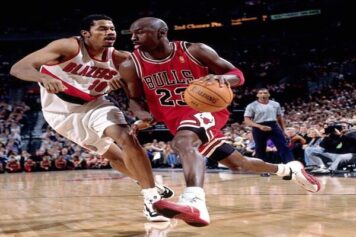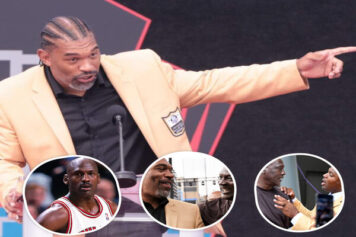When we look at and celebrate Black History, it is an examination of the contributions of the thinkers, artists, activists and innovators that changed the scale and scope of our collective thought process. It’s about the folks that made a difference to the societal aesthetic, that gave this country some much-needed flavor, style and grace, that put a bop in the American step and a way of looking at things in a way that had never before been imagined.
Within the sports tapestry, very few can lay claim to having that type of impact in the way that Julius Erving, aka the great Dr. J did.
You can follow his lineage, which led to Michael Jordan, Kobe and Vince Carter in terms of the aerial pyrotechnics that made us believe that our eyes had the capacity to lie. He didn’t just play the game in such a way that made us jump out of our seats in awe and wonder, but he dramatically altered the way the game was played and how we celebrated and appreciated it.
Doc created a sub-set within the game, a sense of true artistry, with feats that had never been seen before.
While dominating the college landscape at UMASS, he averaged a remarkable 26.3 points and 20.2 rebounds per game during his two varsity seasons. But it was his summer internships at Rucker Park in the 1970’s that elevated his skill set, where he first recognized how his extemporaneous individual expression within the team construct could take the sport to new heights on a national, and later global scale.
At the Rucker back then, Doc was playing in the park’s unquestioned heyday, when NYC legends like Kareem, Tiny Archibald, Joe “The Destroyer” Hammond, Pee Wee Kirkland and others were out there putting their individual stamps on “The City Game.”
As my man Ronnie Flores once wrote, “Most know him as Dr. J, ABA and NBA ambassador of the 1970’s and ’80s. But it’s at Rucker where Erving turned 155th into his own personal playground. Nobody drew a crowd like the Doctor and he was the player all playground legends were judged against. All it took was a good game, or one nice move, against “The Claw,” and anybody was instantly somebody at the Rucker.”
The Claw was what they initially called him, because of his gigantic hands and how he used them to swoop down from angles never seen before to deliver the most audacious rim-wreckers ever known to man. They also called him “Black Moses” and “Houdini”, but Erving let it be known what his true moniker should be.
“Later on, in the Rucker Park league in Harlem, when people started calling me ‘Black Moses’ and ‘Houdini’, I told them if they wanted to call me anything, call me ‘Doctor,'” Erving told the great sports journalist and social commentator Bill Rhoden back in 1975 when he was playing for the New York Nets in the old ABA.
Back then, before the NBA and his championship run with the Philadelphia 76’ers, he was already saddled with an aura of mythic proportions.
Despite the ABA not having a national TV contract, Dr. J’s legend was supremely well known even back then, which speaks to how remarkable he was. It wasn’t spread by SportsCenter highlights or YouTube clips, but by the excited chatter spewing from the mouths of hoops junkies from coast to coast.
Doc began his pro career in the ABA with the Virginia Squires before tearing it up with the Nets. The unequivocal greatest player of his time, he was the sole reason why the ABA merged with the NBA in 1976. In an effort to understand who Doc was back then, I asked the great George Gervin, aka The Iceman, a few years ago, about those early days when the two balled out together on that Squires squad. And I dare you to find a swingman combo today that could do anything against the two of them on the wing. Good’gawd’a’mighty, I wish I could have seen that!

“He was such a great man, and Im not even talking about basketball,” Ice told me. “He took me in. After practice, I would call myself going on to the locker room and Doc would say, ‘Hey Rook! Where you goin? You aint done!’ And me and that brother would play one on one for hours. Doc would dunk on me and dunk on me, man! But I started to develop that confidence. And once I started shooting that jumper on him, then I could go by him. I wasnt as explosive as he was but I would watch him, with those big hands, roll the ball into the hole. So then I started my finger roll.”
So in case you didn’t know, one of the most devastating and majestic offensive weapons that the game has ever seen, The Iceman’s Finger Roll, was born out of competing with Dr. J one on one.
“As a basketball player, Julius was the first to truly take the torch and become the spokesman for the NBA. Julius was the first player I ever remember who transcended sports and was known by one name — Doctor,” Erving’s former coach Billy Cunningham once said.
So as Doc celebrates his birthday today, we just wanted to give that brother a shoutout and thank him for bringing that playground funk to the roundball cipher, and influencing the game in way that still bears his personal stamp.



